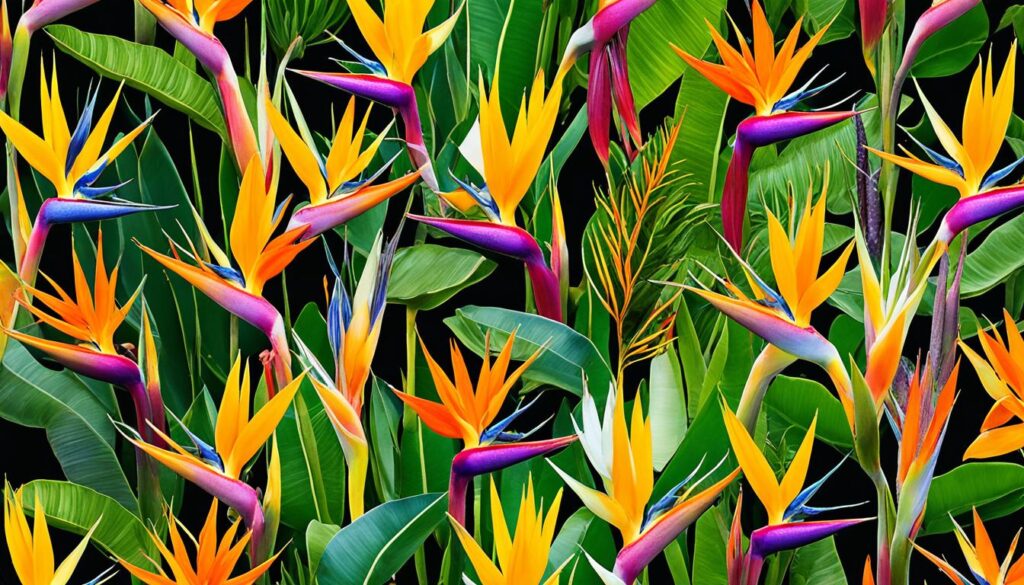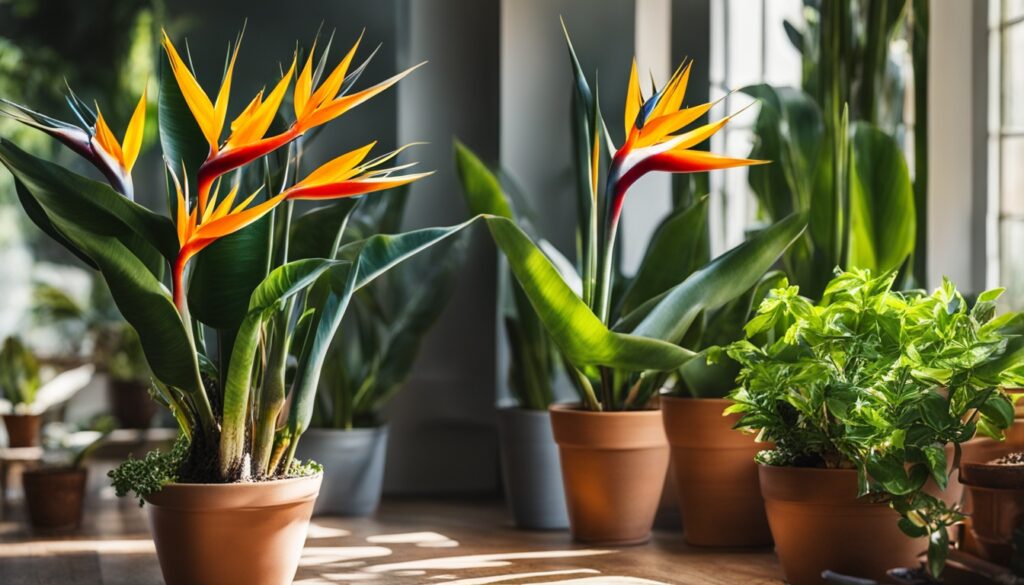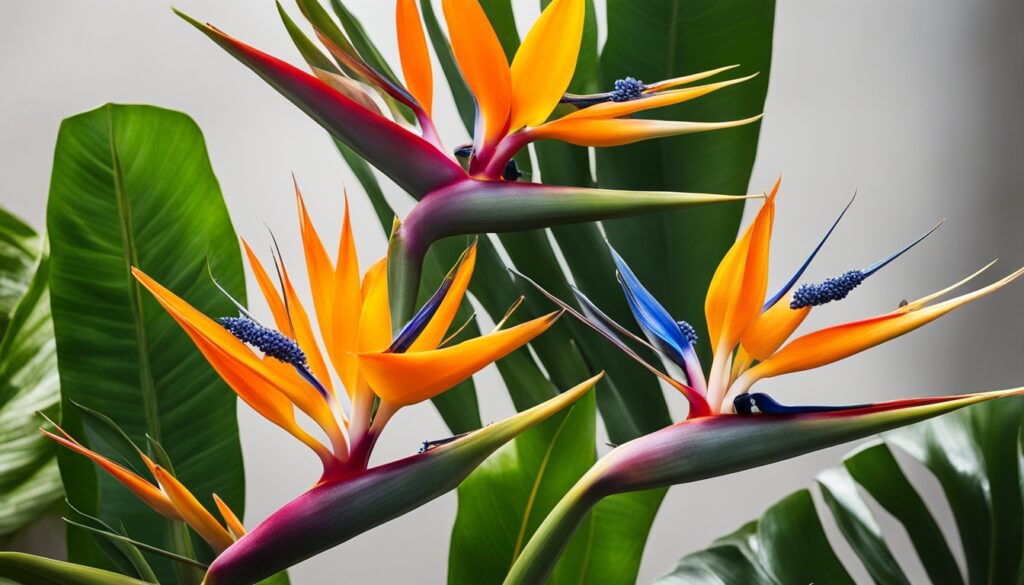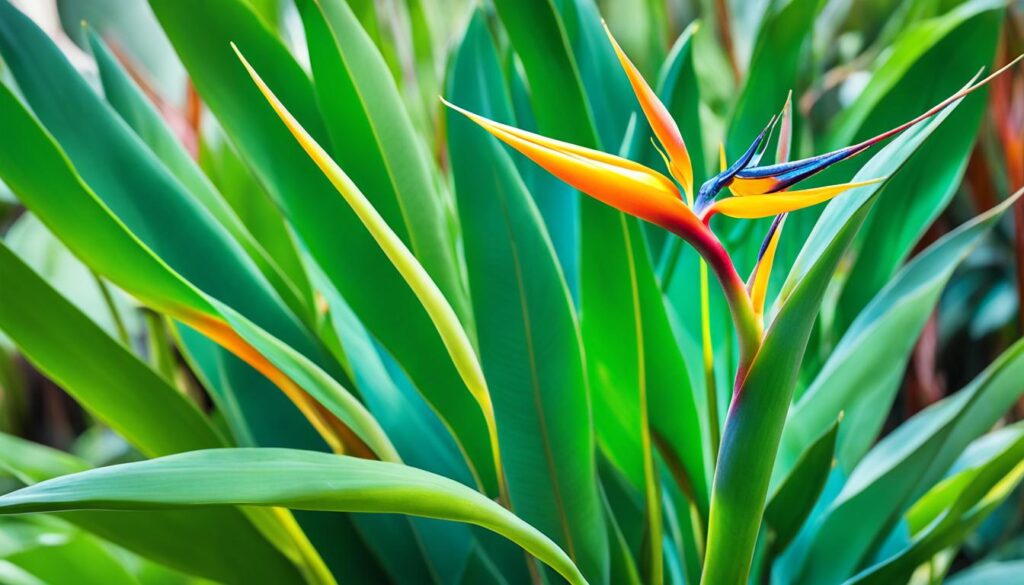Remarkably, the growth rate of indoor bird of paradise plants can reach up to 2-3 leaves per year, with each leaf measuring a substantial 18 to 24 inches in length. These exotic, tropical flowering plants are known for their distinctive, vibrant blooms that resemble the tropical bird of the same name. However, their growth pace may surprise many, as birds of paradise are relatively slow-growing compared to some other popular houseplants. Understanding the factors that influence their development is key to providing the optimal conditions for these stunning plants to thrive.
Key Takeaways
- Bird of paradise plants have a growth rate of 2-3 leaves per year indoors, with each leaf reaching 18-24 inches in length.
- Indoor environments during winter can lead to slower growth rates due to drier conditions.
- Proper care, including consistent moisture, bright indirect light, and regular fertilization, is essential for optimal bird of paradise growth.
- Pruning can encourage fuller, bushier plants and control the size, while repotting every 2-3 years supports healthy development.
- Mature bird of paradise plants can reach impressive heights of 6 to 30 feet, depending on the species.
Introduction to Birds of Paradise Plants
Native Habitat and Characteristics
Native to the tropical regions of South Africa, the birds of paradise are large, herbaceous perennial plants that grow from rhizomes. These lush foliage plants are closely related to the banana plant and are renowned for their distinctive, eye-catching flowers that resemble the tropical bird they are named after. Birds of paradise plants typically feature large, upright leaves that can reach up to 18 inches in length and can develop splits or tears when exposed to windy conditions or brushed against.
These tropical plant growth wonders are generally easy to care for, but their significant size and specific needs make them better suited for experienced indoor gardeners. The Strelitzia Reginae variety can grow up to 6.6 feet tall, while the Strelitzia Nicolai variety can potentially reach a towering 20 feet in height, with large banana-like leaves ranging from 9.8 to 28 inches long.
“Birds of paradise plants are known for their distinctive, eye-catching flowers that resemble the tropical bird they are named after.”
Despite their impressive size, birds of paradise plants generally prioritize height over spread, growing tall rather than wide. With proper care and optimal growing conditions, these lush foliage plants can thrive indoors, providing a touch of the tropics to any space.
Types of Bird of Paradise Plants
The Strelitzia genus is home to several captivating bird of paradise species, each with its own unique characteristics. The most well-known variety is the Strelitzia reginae, or common bird of paradise, with its vibrant orange and blue blooms. However, the Strelitzia family also includes the Strelitzia nicolai, or giant white bird of paradise, the Strelitzia juncea, a drought-resistant species with narrow leaves and smaller orange flowers, and the Strelitzia alba, another white bird of paradise variety.
While all members of the Strelitzia genus share similar care requirements and growth habits, each species offers distinct features. For instance, the Strelitzia nicolai can grow up to 30 feet tall, making it a striking focal point in the landscape, while the Strelitzia juncea remains more compact at around 6.5 feet. The Strelitzia reginae is the most popular choice, valued for its striking, architectural appearance and ease of cultivation.
In addition to the Strelitzia species, the Caesalpinia genus also includes several bird of paradise varieties, such as the Caesalpinia pulcherrima, or red bird of paradise, and the Caesalpinia gilliesii, known as the yellow bird of paradise. These plants share similar growth habits and care requirements with their Strelitzia counterparts, but offer unique color variations to choose from.

Whether you’re drawn to the classic orange and blue blooms of the Strelitzia reginae, the majestic presence of the Strelitzia nicolai, or the vibrant hues of the Caesalpinia varieties, the bird of paradise family offers a diverse range of options to suit any gardener’s preferences. With the right growing conditions, these stunning plants can thrive and bring a touch of the tropics to your outdoor space or indoor oasis.
Do Birds of Paradise Grow Year-Round?
Growth Patterns Indoors vs Outdoors
The growth patterns of birds of paradise plants can vary significantly depending on whether they are grown indoors or outdoors. In their native habitat of South Africa, these tropical plants are able to grow year-round due to the consistently warm temperatures and high humidity. However, when cultivated as indoor plants in cooler climates, their growth may slow down during the winter months.
This seasonal slowdown is primarily due to the fact that birds of paradise thrive in warm, humid conditions and require ample sunlight to maintain their vigorous growth. Indoors, where environments tend to be drier and have less natural light during the winter, the growth rate of these plants can decrease. On the other hand, outdoor-grown birds of paradise may only put on significant growth during the warmer spring and summer months, with their growth slowing down in the cooler fall and winter seasons.
“The bird of paradise plant typically thrives half of the year and flowers in late winter to early spring.”
It’s important to understand these growth patterns when caring for a bird of paradise plant, as it can help you optimize the plant’s growing conditions and ensure it receives the appropriate care throughout the year.
By providing the right balance of light, temperature, and humidity, you can help your bird of paradise plant thrive and reach its full potential, whether it’s growing indoors or outdoors.
How Fast Do Birds of Paradise Grow?
Birds of paradise are relatively slow-growing plants compared to some other popular houseplants. Under optimal growing conditions, indoor birds of paradise can add 2-3 new leaves per year, with each leaf measuring 18-24 inches in length. However, their growth rate can be significantly impacted by factors such as lighting, temperature, and humidity levels.
Factors Affecting Growth Rate
Plants grown in bright, indirect light with consistent temperatures between 70-80°F and moderate humidity will generally grow faster than those in lower light conditions or with fluctuating environmental factors. Birds of paradise plants prefer well-drained, nutrient-rich soil and thrive in a humid environment.
Outdoor birds of paradise may grow faster than their indoor counterparts, as they can benefit from more sunlight and natural weather patterns. The growth rate of these plants can also be influenced by factors such as plant age, pot size, and pruning.
“Bird of paradise typically flowers in the late winter to early spring, and the plant will flower once mature somewhere between 3 to 5 years.”

While the growth rate of birds of paradise may be slower compared to some other houseplants, their large, striking leaves and dramatic flowers make them a popular choice for indoor and outdoor gardens. With the right care and attention, these tropical plants can thrive and bring a touch of the exotic to any space.
How New Growth Appears
As a tropical plant, the bird of paradise is known for its impressive foliage development. New growth on these plants typically emerges from the center of the plant as new leaves unfurl. Depending on the growing conditions, it can take several weeks for a single leaf to fully mature and contribute to the overall size and density of the plant.
While bird of paradise plants may not be the fastest-growing houseplants, their large size and striking foliage make any new bird of paradise leaf growth and new foliage development noteworthy. The tropical plant growth patterns of these plants create a sense of drama and anticipation as gardeners watch their bird of paradise slowly but steadily expand over time.
One of the key characteristics of bird of paradise growth is the unfurling of new leaves. As a new leaf emerges from the center of the plant, it gradually unfolds and stretches out, revealing the distinctive blue-green hues and impressive size that are hallmarks of this tropical beauty.
“The large, paddle-shaped leaves of the bird of paradise plant can reach up to 1.5 feet in length, contributing to the plant’s overall lush and exotic appearance.”
While the growth rate may not be lightning-fast, the steady development of new foliage is a captivating process to observe. Gardeners who are patient and provide the right growing conditions can look forward to watching their bird of paradise plant mature and fill out over time.
Optimizing Growing Conditions for Faster Growth
When it comes to growing birds of paradise, providing the optimal conditions is key to achieving faster maturation. These tropical plants thrive in specific environments, and by understanding their water, light, soil, and humidity requirements, gardeners can create the perfect setting for accelerated growth.
Ideal Water, Light, Soil, and Humidity
Birds of paradise prefer consistently moist, well-draining soil. To ensure proper hydration, water the plants regularly, allowing the soil to dry out slightly between waterings to avoid waterlogging and root rot. These plants also require bright, indirect light to reach their full potential, as they naturally grow in tropical conditions with ample sunlight.
- Use a nutrient-rich, well-draining potting mix to support healthy root growth.
- Fertilize regularly during the growing season to provide essential nutrients for faster development.
- Maintain moderate to high humidity levels, either through the use of a humidifier or by misting the leaves, to mimic their native environment.
By carefully managing the water, light, soil, and humidity for your bird of paradise, you can create the optimal growing conditions that will encourage faster maturation and vigorous growth.

“Providing the ideal growing conditions is crucial for birds of paradise to reach their full potential and mature at a faster rate.”
Effects of Pruning on Growth Rate
When it comes to growing Birds of Paradise plants, pruning can play a significant role in influencing their growth rate. While pruning may not necessarily lead to faster overall growth, it can provide other important benefits for the plant’s development and appearance.
One of the primary effects of pruning on bird of paradise pruning is that it can redirect the plant’s energy towards new growth. By removing dead, damaged, or yellowing leaves, you can encourage the plant to focus its resources on producing fresh, healthy foliage. This process can stimulate the development of new shoots and leaves, giving the plant a more compact, bushy, and visually appealing shape.
Additionally, pruning effects on growth can also help manage the plant’s size and structure. Cutting back the stems may trigger the formation of new growth, preventing the plant from becoming leggy or overly spindly. This can be particularly beneficial for maintaining the plant’s plant maintenance and preventing it from becoming unruly or difficult to manage.
“Proper pruning can be a game-changer for the growth and appearance of your Birds of Paradise plant.”
However, it’s important to note that excessive or improper pruning can be detrimental to the plant’s health and growth. When pruning, it’s crucial to use clean, sharp pruning shears and cut just above a leaf node to promote healthy new growth. Cutting too far back or removing too much foliage can stress the plant and potentially slow its overall development.
By understanding the effects of pruning on the growth rate of Birds of Paradise plants, gardeners and plant enthusiasts can effectively maintain and enhance the visual appeal of these stunning tropical specimens. With the right pruning techniques and a keen eye for the plant’s needs, you can ensure your Birds of Paradise thrive and reach their full potential.
Mature Size and Blooming
Birds of paradise are known for their impressive, exotic blooms, but did you know that these plants also grow to substantial mature sizes? On average, a fully grown bird of paradise can reach up to 6 feet tall and 4 feet wide, making a bold statement in any indoor or outdoor setting.
To support this bird of paradise mature size, regular repotting is essential. These plants typically require repotting every 2-3 years or when the root system outgrows its current container. Interestingly, allowing the plant to become slightly pot-bound can actually trigger bird of paradise blooming, as a certain level of maturity and root restriction is often needed before they will flower.
Repotting and Bloom Requirements
Once a bird of paradise reaches a height of 3-4 feet, it is generally ready to start blooming. However, providing the right growing conditions is also key to bloom triggers. Ample sunlight, consistent watering, and proper soil nutrition all play a vital role in encouraging these plants to showcase their stunning, vibrant blooms.

“Birds of paradise are a true horticultural marvel, captivating gardeners and plant enthusiasts alike with their majestic size and breathtaking flowers.”
By understanding the repotting requirements and bloom triggers for these remarkable plants, you can ensure your bird of paradise thrives and reaches its full potential, delighting you with its regal presence and exotic blooms for years to come.
Care and Maintenance
Proper care and maintenance are crucial for the long-term health and growth of birds of paradise. These vibrant plants require a delicate balance of watering, sunlight, and environmental conditions to thrive. Neglecting their care can lead to a range of issues, from pest infestations to disease outbreaks.
Overwintering, Pests, and Disease Management
In cooler climates, overwintering birds of paradise indoors is necessary to protect them from frost damage. This process involves reducing watering and cutting back the foliage to help the plant conserve energy and survive the colder months. Additionally, birds of paradise are susceptible to pests like aphids, scale, and whiteflies, which can quickly compromise the plant’s health. Treating any infestations with insecticidal soap or systemic pesticides can help control these issues.
Birds of paradise are also vulnerable to Botrytis cinerea (gray mold), a fungal disease that can cause dark spots and a layer of gray mold on the leaves and flowers. Removing affected plant parts and improving air circulation can help mitigate this disease and maintain the overall plant health.
- Overwintering birds of paradise indoors to protect from frost damage
- Reducing watering and cutting back foliage during the winter months
- Treating pest infestations with insecticidal soap or systemic pesticides
- Controlling Botrytis cinerea (gray mold) by removing affected plant parts and improving air circulation
By staying vigilant and addressing any bird of paradise care issues promptly, gardeners can ensure the long-term health and vibrancy of these stunning tropical plants.
Propagation Methods
For bird of paradise enthusiasts, propagating these stunning plants can be a rewarding experience. There are two primary methods for multiplying bird of paradise plants: division and seed propagation. Each approach has its own advantages, so understanding the nuances can help gardeners choose the best technique for their needs.
Division: A Faster and Easier Option
Division is generally the simpler and quicker way to propagate bird of paradise plants. This method involves separating the rhizomes or offsets from a mature, previously blooming plant and repotting them. Gardeners can use larger tools like shovels and saws for in-ground or large plants, or a sharp knife for smaller potted specimens. With division, new plants can often be established in a matter of weeks.
Seed Propagation: A More Challenging Approach
Seed propagation, on the other hand, can be a more time-consuming process. It can take up to two months for bird of paradise seeds to germinate. Proper seed preparation, including soaking and nicking, is essential for successful seed-based bird of paradise propagation. While seed propagation may require more patience, it can be a rewarding way to introduce genetic diversity to a bird of paradise collection.
Ultimately, the choice between division and seed propagation depends on the gardener’s goals, resources, and level of experience. Both methods can be successful, but understanding the unique characteristics of each approach is key to achieving the best results.

Troubleshooting Growth Issues
The majestic bird of paradise plant is known for its stunning foliage and vibrant flowers, but even these tropical beauties can encounter a few common growth problems. By understanding the potential causes and taking prompt action, you can help your bird of paradise thrive and reach its full potential.
One of the most prevalent issues with bird of paradise plants is root rot, often caused by overwatering. If you notice a rotting smell or see the roots turning brown and mushy, it’s time to address the problem. Improve drainage, allow the soil to dry out between waterings, and consider repotting the plant in fresh, well-draining soil.
On the other hand, yellowing leaves can indicate that the plant isn’t getting enough water. Check the soil moisture regularly and increase watering if needed. Curling or wilting leaves may also signal underwatering, so be sure to give your bird of paradise a thorough soak when the top inch of soil becomes dry.
Stunted growth or lack of new leaf development can often be traced back to insufficient light. These plants thrive in bright, indirect sunlight, so make sure to place them in a location that receives ample natural illumination. If needed, supplement with artificial grow lights to ensure your bird of paradise gets the light it craves.
Diligent monitoring and prompt troubleshooting can help you overcome these common bird of paradise growth problems and keep your plant healthy and vibrant. Remember, a little TLC can go a long way in helping these tropical wonders reach their full potential.
“With the right care and attention, your bird of paradise can thrive and bring a touch of the tropics to your indoor or outdoor space.”
Conclusion
Birds of paradise are remarkable, slow-growing tropical plants that can add a touch of exotic flair to any indoor or outdoor garden. While they may not be the fastest-growing houseplants, with the right care and attention, these plants can thrive and eventually reward growers with their stunning, vibrant blooms. By understanding the key growth facts, such as their mature size and bloom requirements, and following essential care tips like providing optimal growing conditions and addressing potential issues, gardeners can help their birds of paradise reach their full potential and enjoy their lush foliage and spectacular flowers for years to come.
Whether you’re growing a Strelitzia reginae or a Strelitzia nicolai, these captivating plants offer a unique and valuable addition to any plant collection. With patience and dedication, you can create the perfect environment for your bird of paradise to flourish, allowing you to witness its remarkable growth and the eventual emergence of its breathtaking flowers. By summarizing the essential information covered throughout this article, we hope you feel empowered to make the most of your bird of paradise journey and cultivate a thriving, healthy plant in your own space.
Remember, the key to successfully growing birds of paradise lies in understanding their specific needs, optimizing their growing conditions, and providing them with the care and attention they require. With this knowledge in hand, you can embark on an exciting and rewarding journey of nurturing these captivating plants and enjoying their beauty for years to come.
FAQ
How fast do birds of paradise grow?
Birds of paradise are relatively slow-growing plants compared to some other houseplants. Under optimal conditions, they can add 2-3 new leaves per year, with each leaf reaching 18-24 inches in length. However, their growth rate can be significantly impacted by factors like lighting, temperature, and humidity levels.
What is the growth rate of birds of paradise plants?
The growth rate of birds of paradise can vary depending on whether they are grown indoors or outdoors. Outdoor-grown plants may only put on significant growth during the warmer spring and summer months, while indoor plants may slow down during the winter due to less natural light and fluctuating environmental conditions.
How do I care for a bird of paradise plant?
To encourage faster growth in birds of paradise, it’s essential to provide optimal growing conditions. These plants prefer consistently moist, well-draining soil, bright indirect light, and moderate to high humidity levels. Using a nutrient-rich potting mix and fertilizing regularly during the growing season can also support their development.
Can pruning a bird of paradise plant increase its growth rate?
Pruning a bird of paradise plant may not necessarily lead to faster overall growth, but it can provide other benefits. Removing dead or yellowing leaves can redirect the plant’s energy towards new growth, and pruning can also encourage a fuller, bushier appearance by removing leggy or spindly growth.
How big do birds of paradise plants grow?
Birds of paradise can grow to impressive sizes, reaching up to 6 feet tall and 4 feet wide at maturity. To support this growth, they need to be repotted every 2-3 years or when the plant outgrows its current container.
What are the common growth issues with birds of paradise?
Birds of paradise can encounter growth issues such as root rot from overwatering, yellowing leaves from underwatering, and stunted growth from inadequate light. Monitoring the plant’s soil moisture, checking for signs of pests or disease, and ensuring optimal growing conditions can help address these problems.
How can I propagate a bird of paradise plant?
There are two primary methods for propagating birds of paradise: division and seed propagation. Division is generally the easier and quicker option, as it involves separating the rhizomes or offsets from a mature, previously blooming plant and repotting them.


Hey there! Do you know if they make any plugins to assist with Search Engine Optimization? I’m trying to get my blog to rank
for some targeted keywords but I’m not seeing very good results.
If you know of any please share. Thanks! You can read similar text here:
Eco blankets
Good day! Do you know if they make any plugins to help with Search Engine Optimization? I’m trying to get my website to rank for
some targeted keywords but I’m not seeing very good gains.
If you know of any please share. Thank you! You can read similar text here:
Change your life
I’m really impressed together with your writing abilities as neatly as
with the layout on your blog. Is that this a paid subject matter or did you modify it yourself?
Anyway keep up the nice quality writing, it is uncommon to see a nice weblog like
this one nowadays. Snipfeed!
I am really impressed with your writing skills and also with
the format in your weblog. Is that this a paid theme or did you customize it yourself?
Anyway stay up the excellent high quality writing,
it’s rare to peer a great weblog like this one these days.
Madgicx!
Wow, this article is fastidious, my younger sister is analyzing these things, so I am going to let know her.
Hey there! Quick question that’s completely off topic.
Do you know how to make your site mobile friendly? My blog looks weird when browsing from
my iphone4. I’m trying to find a template or plugin that might be able to fix this issue.
If you have any suggestions, please share.
Thanks!
Hello colleagues, fastidious article and pleasant arguments commented
here, I am truly enjoying by these.
After checking out a number of the articles on your site, I seriously appreciate your way of blogging.
I book marked it to my bookmark site list and will be
checking back in the near future. Please visit my web site as well and tell me what you think.
I do not know whether it’s just me or if perhaps everyone else encountering problems with
your blog. It appears as if some of the written text on your posts are running
off the screen. Can somebody else please comment and let me
know if this is happening to them too? This could be a problem with my browser because I’ve had
this happen before. Many thanks
I like what you guys tend to be up too. This kind of clever work and coverage!
Keep up the wonderful works guys I’ve included you guys to my blogroll.
Great delivery. Outstanding arguments. Keep
up the good effort.
Hey! I just wanted to ask if you ever have any issues with hackers?
My last blog (wordpress) was hacked and I ended up losing many months of hard work due to no backup.
Do you have any methods to stop hackers?
Just wish to say your article is as astonishing. The clearness for your publish
is simply nice and i could assume you are an expert in this subject.
Fine along with your permission let me to clutch your RSS feed to keep up to date with coming near near post.
Thanks 1,000,000 and please continue the rewarding work.
Wonderful site you have here but I was curious about
if you knew of any community forums that cover the same topics
talked about in this article? I’d really like
to be a part of group where I can get feedback from other experienced people that share the same interest.
If you have any suggestions, please let me know. Thanks!
I just like the valuable information you provide to your articles.
I’ll bookmark your weblog and check again here regularly.
I’m rather certain I’ll be informed a lot of new stuff proper right here!
Best of luck for the next!
Undeniably believe that which you said. Your favorite justification appeared to be
on the web the easiest thing to be aware of. I say
to you, I certainly get irked while people think about worries that they plainly don’t know about.
You managed to hit the nail upon the top as well as defined out the whole thing without having side-effects
, people can take a signal. Will probably be back to get
more. Thanks
Great post. I was checking continuously this blog and I’m impressed!
Extremely useful info specially the last part 🙂 I care for such information a lot.
I was seeking this certain information for a long time.
Thank you and best of luck.
We stumbled over here from a different website
and thought I may as well check things out. I like what I see so now i am following you.
Look forward to checking out your web page for a second time.
Hola! I’ve been following your blog for a long time now and finally got
the courage to go ahead and give you a shout out from Humble Tx!
Just wanted to say keep up the fantastic job!
Also visit my blog post :: how to use tronswap
Right away I am going to do my breakfast, once having
my breakfast coming again to read more news.
Thanks for sharing your thoughts about watchhotporn.net.
Regards
I like the valuable information you provide in your articles.
I will bookmark your blog and check again here regularly.
I’m quite certain I will learn many new stuff right here!
Best of luck for the next!
I am extremely inspired along with your writing skills and also with the format for your blog.
Is that this a paid subject matter or did you modify it your self?
Anyway stay up the excellent quality writing, it
is rare to peer a nice blog like this one today.
Instagram Auto comment!
No matter if some one searches for his vital thing, thus he/she desires
to be available that in detail, so that thing is maintained
over here.
Pretty! This was an extremely wonderful article. Thanks for providing these details.
Usually I don’t read post on blogs, however I would like to say that this write-up very pressured me to take a look at and do so!
Your writing taste has been surprised me. Thank you, quite nice
post.
Hey, I think your blog might be having browser compatibility issues.
When I look at your blog site in Opera, it looks fine but when opening
in Internet Explorer, it has some overlapping.
I just wanted to give you a quick heads up! Other then that, excellent blog!
Wow, fantastic blog layout! How long have you
been blogging for? you made blogging look easy. The overall look of your website is great, let alone the content!
This is really attention-grabbing, You’re a very skilled blogger.
I have joined your rss feed and stay up for looking for extra of your wonderful post.
Additionally, I have shared your website in my social networks
What you composed made a lot of sense. But, consider this, suppose you
added a little information? I mean, I don’t want to tell
you how to run your blog, but suppose you added a headline that makes people
want more? I mean Birds of Paradise Growth: How Fast Do They
Mature? – We Love Talk Birds is kinda plain. You ought
to look at Yahoo’s home page and see how they create
news titles to get viewers to open the links. You might try adding a video or a pic or two to get people excited about everything’ve written. Just my opinion, it would make your blog a little bit more interesting.
If you would like to take much from this piece of writing then you have to apply such methods to your won blog.
Aftewr going over a hqndful of tthe blopg articles oon yopur
site, I seriously like your waay oof blogging.
I saaved as a favorite iit tto mmy bookmarkk website listt annd wiol bee checking back soon. Takee a
lkok aat myy website as welll and let me know yojr opinion.
Way cool! Some extremely valid points! I appreciate you
writing this write-up and the rest of the site is very good.